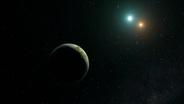- Are we alone in the universe?
In the 1970s when "Star Wars" first came out with tons of planets and aliens, here in reality, we didn't have evidence of a single planet beyond our solar system.
Today, we know of thousands.
So how did we get here?
(bright music) In 1992, scientists combed through data from a pulsar, a type of dead star.
As a pulsar rotates, it emits a powerful beam of radio waves that, from the perspective of Earth, you might have guessed, pulses.
But when they looked at the rhythm of the pulses, something was off.
They figured out that what was throwing the rhythm off was the mass of two big objects near the pulsar.
Planets.
Three years later, in 1995, a different team of scientists measured the wobble of a sun-like star's position in space, and realized that the wobble could be caused by a giant planet, about 50% bigger than Jupiter, and to the surprise of astronomers everywhere, it was a lot closer to the star than expected.
This discovery completely revolutionized what astronomers thought about how planetary systems form around a star, and it kick-started the hunt for more planets.
Over the last three decades, thanks to telescopes on Earth and in space, astronomers have found more than 5,000 exoplanets in all kinds of sizes and temperatures.
Exoplanets are so common, scientists have estimated there could be 100 billion or more in the Milky Way galaxy alone.
Though we haven't found ET yet, we think there are a lot of potential worlds out there, so the hunt continues.
(gentle music)














